Matt Doyle from Monageer has a gift for bringing vintage machinery to life.
On the day Irish Country Living visits Johnstown Castle in Co Wexford, he is fixing a door on a shiny blue Mulhall’s of Kilkenny bread van. Bringing back childhood memories from the Marble city, the Minister of State for Heritage and Electoral Reform, Malcolm Noonan, tells ICL that he is especially keen to see this piece.
The minister is visiting Johnstown Castle – home to the Irish Agricultural Museum – to open the renovated east-wing of the castle and launch the Complete Guide to Volunteering at the Irish Heritage Trust (IHT).
The Irish Heritage Trust manages historic properties and gardens around the country, such as Johnstown Castle Estate, Museum and Gardens in Wexford; Fota House, Arboretum and Gardens in Cork; and Strokestown Park House, Gardens and National Famine Museum in Roscommon.
More than a building
Producing a guide to volunteering is a priority for the CEO of the IHT, Anne O’Donoghue: “When people look at what we do, it can seem it is all about the buildings,” she says.
“You can do a magnificent job in restoring a building; in presenting beautiful parkland, but it really comes to life when people come and form their own relationships with it.”
Volunteers tend to be from the locality and, in many cases, have links to the properties; relatives may have worked here.
“The enduring connections between volunteers from the community and these special places mean that our heritage will be protected and our social history brought to life for generations to come,” says Anne.
Vintage enthusiasts
Matt encouraged his brother, John Doyle, to volunteer and last year, local Wexford man, John Furlong from Arthurstown, joined the team.
“I retired from Templetuohy Farm Machinery (TFM) in Enniscorthy and went to the volunteer centre in Wexford, looking for something to keep me occupied, and that’s how I ended up here,” he says.
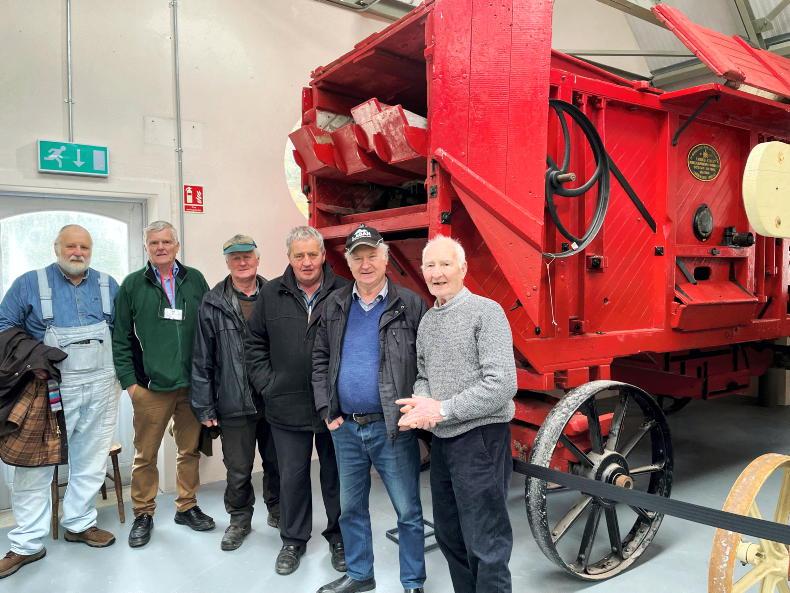
Volunteers at the Irish Agricultural Museum at Johnstown Castle Estate and Gardens, from L-R: Chris Hadlington; Peter Miller, Chair of the Museum; Matt Doyle, Monageer; John Furlong, Adamstown; John Doyle, Monageer; Sean Furlong, Wexford town. / Caitríona Bolger
“I was roped into it and didn’t know what I was letting myself in for,” adds the longest serving volunteer at the Irish Agricultural Museum, Séan Furlong.
“We come down every Tuesday and work on the items; restoring them, cleaning them up, sand-blasting, painting and rotating the machinery around,” explains Chair of the Museum, Peter Miller.
“We don’t be working all that time,” chips in Séan, who is retired from driving the mobile library with Wexford County Council after 40 years’ service.
Bringing
history alive
Mick Byrne is a volunteer guide at Johnstown Castle. He brings Irish Country Living on a tour of the castle – starting at the front door and taking us back to the 1100s. He points out the symbolism on the ornate wood work along the entrance hall, including some religious references. While these features remain, there is a void left in the light-filled hall, by the absence of the sweeping double staircase which was handcrafted from Irish oak. He explains that this staircase was one of only four made at the time; one other was on the Titanic.
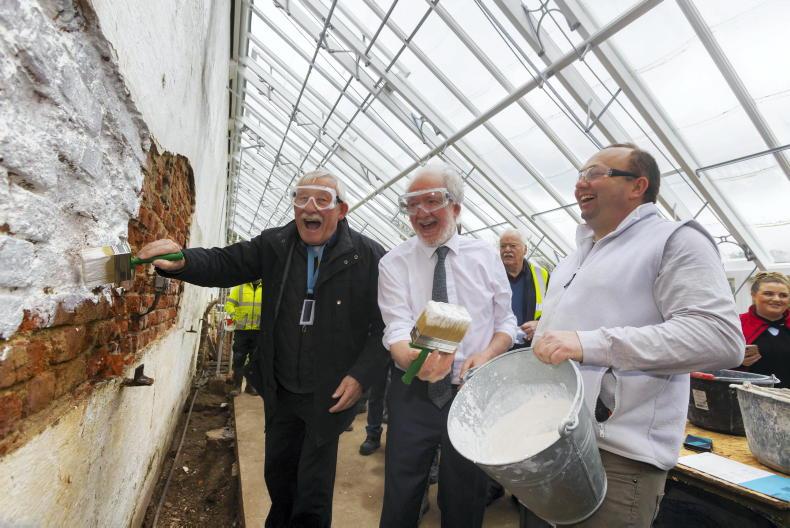
Minister for Heritage, Malcolm Noonan taking part in a lime-plastering workshop at Johnstown Castle. / Patrick Browne
Upstairs, he brings us around the sitting room and references the large mirrors on the wall, casually mentioning that multiple were made for the family. Why? Because they weren’t being delivered by lorry; the horse and cart was a bumpy method of transport, and breakages had to be taken into account along the delivery route.
As he shares an enriching cultural experience of our country’s heritage with us, he feels he gets something back too.
“Volunteering at Johnstown Castle has afforded me the opportunity to learn and reconnect with the rich history of Ireland, the castle, its occupants and the impact of national and world events on its occupants,” he tells us.
“Sharing this knowledge with locals and visitors from afar provides a great sense of accomplishment and satisfaction.”
People, place, participation
Voluntary roles within the Trust include gardening, stewarding, restoration projects and customer service on a regular or one-off basis.
Since being established in 2006, volunteering has been part of the heritage story at the IHT. There are now more than 300 people volunteering at the properties around the country.
Anne served 10 years on the board of the Trust in a voluntary capacity before stepping into the role of CEO.
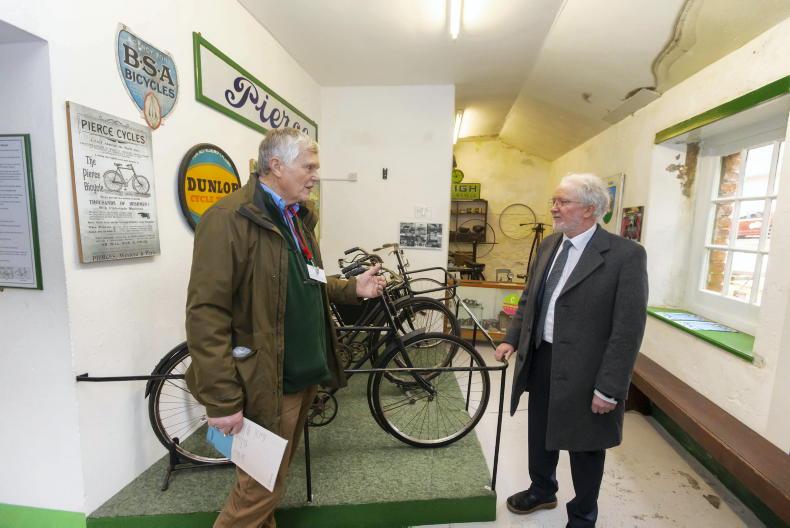
Peter Miller, Chair, Irish Agricultural Museum introducing Minister for Heritage, Malcolm Noonan to a display of Wexford bicycle company, Pierce and Co. / Patrick Browne
“I became very passionate, not just about the physical bricks and mortar of the properties that are in our care and the beautiful landscaping, but with the stories that they held,” she describes.
“Volunteers help us bring to life our ethos of ‘people, place, participation’, something which underpins all of our work.”
From a farm in Tallow, west Waterford, Anne says that for people like her, volunteering is in the DNA.
“We see it everywhere around us; whether it is GAA or Macra. I have grown up knowing that being part of your community is giving back to it,” she says.
By publishing a guide to volunteering with the Trust, Anne emphasises that there is a focus on it being a mutually beneficial experience.
The minister, drawing on his own experience of volunteering over the years, made the point of how it was important to find “the right fit for what you want to be involved in”, referring to the unique opportunities that are available at these heritage properties.
This is something the volunteer centres in each county can help with.
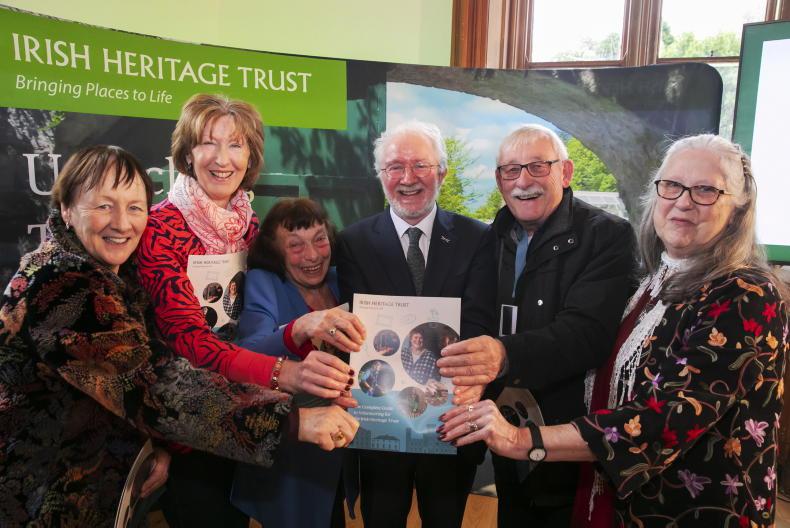
Minister of State for Heritage and Electoral Reform, Malcolm Noonan, with volunteers from the Irish Heritage Trust at Johnstown Castle. / Patrick Browne
On the day, his enthusiasm for the role was appreciated by all as he rolled up his sleeves and got stuck into a lime plastering workshop, led by Brian Tobin. Here, Brian passed on these skills to the staff and volunteers present, so they can then share these with visitors to their properties.
“It is a start. We hope to do other workshops,” says Anne.
“It is not about remembering the past; it’s sharing with the generations to come what made Ireland such a successful country and that gives me great joy.”
Eva Law, manager of Wexford Volunteer Centre:
“We only recruit volunteers for organisations who have supports in place; a volunteer policy, training, a go-to person. We are trying to keep volunteering in Wexford to a certain standard, so they are recognised for the work they are doing.
“For example, last year Rosslare Europort was the highest entry point for people coming from Ukraine.
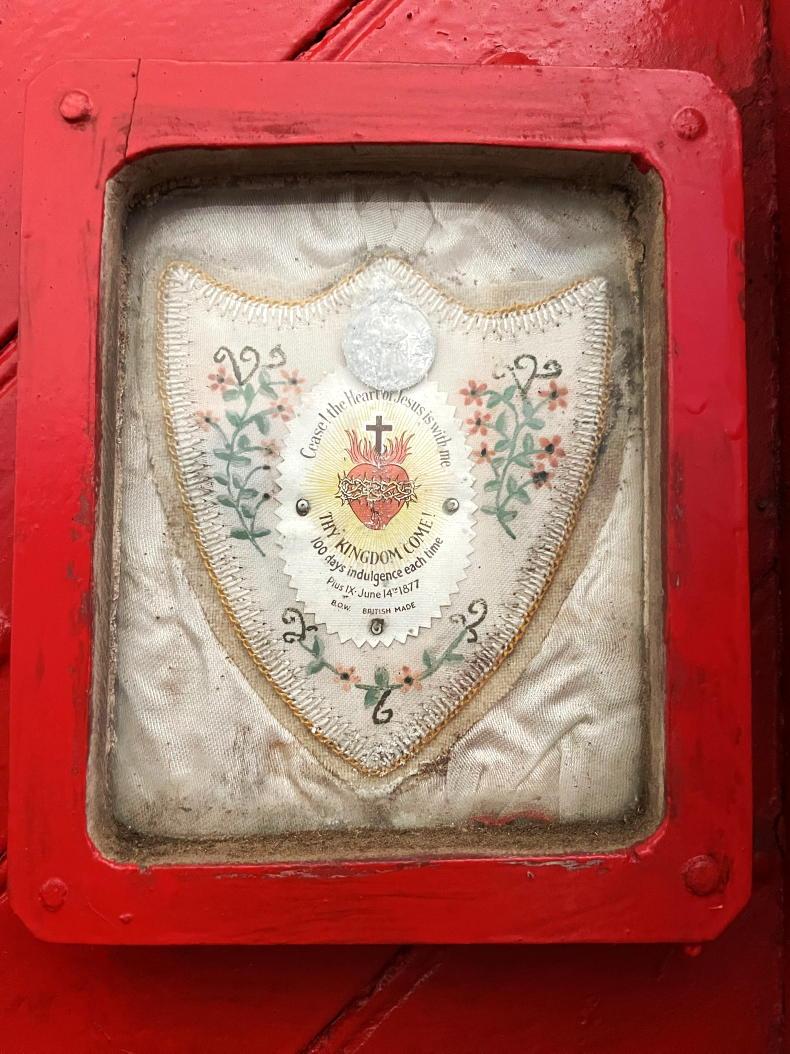
Prayer on a threshing machine dating from the 1800s. / Caitríona Bolger
We had over 100 volunteers onsite, and so I went out to see what exactly I was sending volunteers out to.
“People might come in with an expectation of what volunteering is about, but once we start to tell them the variety of opportunities we have, they are more inclined to try something different.
“I’ve met people who have been farming their whole life, or who have been in the bank and rather than doing outdoor work or admin work, they might be happier guiding tours around a castle – a change of scenery that feeds into their hobby.
“There are volunteer centres in the 26 counties and we work with people to suit their availability and their interests.”
Matt Doyle from Monageer has a gift for bringing vintage machinery to life.
On the day Irish Country Living visits Johnstown Castle in Co Wexford, he is fixing a door on a shiny blue Mulhall’s of Kilkenny bread van. Bringing back childhood memories from the Marble city, the Minister of State for Heritage and Electoral Reform, Malcolm Noonan, tells ICL that he is especially keen to see this piece.
The minister is visiting Johnstown Castle – home to the Irish Agricultural Museum – to open the renovated east-wing of the castle and launch the Complete Guide to Volunteering at the Irish Heritage Trust (IHT).
The Irish Heritage Trust manages historic properties and gardens around the country, such as Johnstown Castle Estate, Museum and Gardens in Wexford; Fota House, Arboretum and Gardens in Cork; and Strokestown Park House, Gardens and National Famine Museum in Roscommon.
More than a building
Producing a guide to volunteering is a priority for the CEO of the IHT, Anne O’Donoghue: “When people look at what we do, it can seem it is all about the buildings,” she says.
“You can do a magnificent job in restoring a building; in presenting beautiful parkland, but it really comes to life when people come and form their own relationships with it.”
Volunteers tend to be from the locality and, in many cases, have links to the properties; relatives may have worked here.
“The enduring connections between volunteers from the community and these special places mean that our heritage will be protected and our social history brought to life for generations to come,” says Anne.
Vintage enthusiasts
Matt encouraged his brother, John Doyle, to volunteer and last year, local Wexford man, John Furlong from Arthurstown, joined the team.
“I retired from Templetuohy Farm Machinery (TFM) in Enniscorthy and went to the volunteer centre in Wexford, looking for something to keep me occupied, and that’s how I ended up here,” he says.

Volunteers at the Irish Agricultural Museum at Johnstown Castle Estate and Gardens, from L-R: Chris Hadlington; Peter Miller, Chair of the Museum; Matt Doyle, Monageer; John Furlong, Adamstown; John Doyle, Monageer; Sean Furlong, Wexford town. / Caitríona Bolger
“I was roped into it and didn’t know what I was letting myself in for,” adds the longest serving volunteer at the Irish Agricultural Museum, Séan Furlong.
“We come down every Tuesday and work on the items; restoring them, cleaning them up, sand-blasting, painting and rotating the machinery around,” explains Chair of the Museum, Peter Miller.
“We don’t be working all that time,” chips in Séan, who is retired from driving the mobile library with Wexford County Council after 40 years’ service.
Bringing
history alive
Mick Byrne is a volunteer guide at Johnstown Castle. He brings Irish Country Living on a tour of the castle – starting at the front door and taking us back to the 1100s. He points out the symbolism on the ornate wood work along the entrance hall, including some religious references. While these features remain, there is a void left in the light-filled hall, by the absence of the sweeping double staircase which was handcrafted from Irish oak. He explains that this staircase was one of only four made at the time; one other was on the Titanic.

Minister for Heritage, Malcolm Noonan taking part in a lime-plastering workshop at Johnstown Castle. / Patrick Browne
Upstairs, he brings us around the sitting room and references the large mirrors on the wall, casually mentioning that multiple were made for the family. Why? Because they weren’t being delivered by lorry; the horse and cart was a bumpy method of transport, and breakages had to be taken into account along the delivery route.
As he shares an enriching cultural experience of our country’s heritage with us, he feels he gets something back too.
“Volunteering at Johnstown Castle has afforded me the opportunity to learn and reconnect with the rich history of Ireland, the castle, its occupants and the impact of national and world events on its occupants,” he tells us.
“Sharing this knowledge with locals and visitors from afar provides a great sense of accomplishment and satisfaction.”
People, place, participation
Voluntary roles within the Trust include gardening, stewarding, restoration projects and customer service on a regular or one-off basis.
Since being established in 2006, volunteering has been part of the heritage story at the IHT. There are now more than 300 people volunteering at the properties around the country.
Anne served 10 years on the board of the Trust in a voluntary capacity before stepping into the role of CEO.

Peter Miller, Chair, Irish Agricultural Museum introducing Minister for Heritage, Malcolm Noonan to a display of Wexford bicycle company, Pierce and Co. / Patrick Browne
“I became very passionate, not just about the physical bricks and mortar of the properties that are in our care and the beautiful landscaping, but with the stories that they held,” she describes.
“Volunteers help us bring to life our ethos of ‘people, place, participation’, something which underpins all of our work.”
From a farm in Tallow, west Waterford, Anne says that for people like her, volunteering is in the DNA.
“We see it everywhere around us; whether it is GAA or Macra. I have grown up knowing that being part of your community is giving back to it,” she says.
By publishing a guide to volunteering with the Trust, Anne emphasises that there is a focus on it being a mutually beneficial experience.
The minister, drawing on his own experience of volunteering over the years, made the point of how it was important to find “the right fit for what you want to be involved in”, referring to the unique opportunities that are available at these heritage properties.
This is something the volunteer centres in each county can help with.

Minister of State for Heritage and Electoral Reform, Malcolm Noonan, with volunteers from the Irish Heritage Trust at Johnstown Castle. / Patrick Browne
On the day, his enthusiasm for the role was appreciated by all as he rolled up his sleeves and got stuck into a lime plastering workshop, led by Brian Tobin. Here, Brian passed on these skills to the staff and volunteers present, so they can then share these with visitors to their properties.
“It is a start. We hope to do other workshops,” says Anne.
“It is not about remembering the past; it’s sharing with the generations to come what made Ireland such a successful country and that gives me great joy.”
Eva Law, manager of Wexford Volunteer Centre:
“We only recruit volunteers for organisations who have supports in place; a volunteer policy, training, a go-to person. We are trying to keep volunteering in Wexford to a certain standard, so they are recognised for the work they are doing.
“For example, last year Rosslare Europort was the highest entry point for people coming from Ukraine.

Prayer on a threshing machine dating from the 1800s. / Caitríona Bolger
We had over 100 volunteers onsite, and so I went out to see what exactly I was sending volunteers out to.
“People might come in with an expectation of what volunteering is about, but once we start to tell them the variety of opportunities we have, they are more inclined to try something different.
“I’ve met people who have been farming their whole life, or who have been in the bank and rather than doing outdoor work or admin work, they might be happier guiding tours around a castle – a change of scenery that feeds into their hobby.
“There are volunteer centres in the 26 counties and we work with people to suit their availability and their interests.”











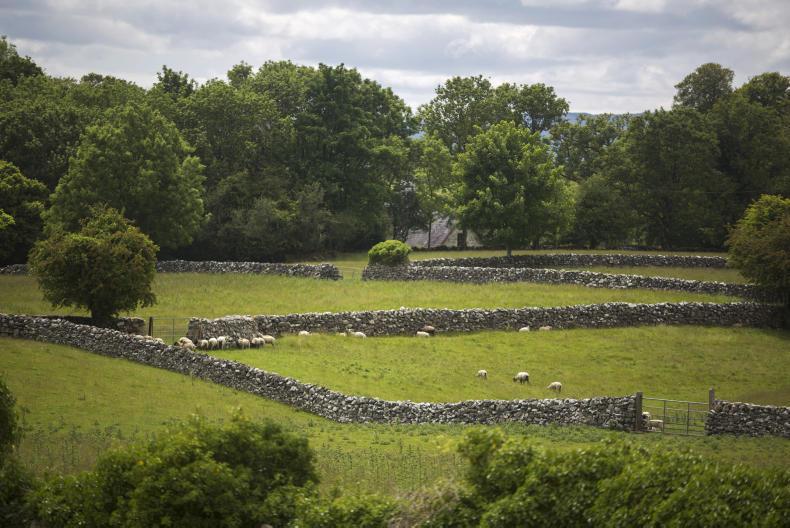


SHARING OPTIONS